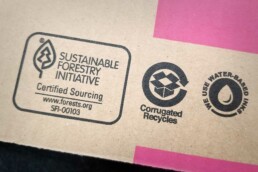Cheap Ways to Reduce E-commerce Emissions
The global movement toward sustainability requires greener solutions for e-commerce and online shopping. Today we’ll be covering the cheapest and easiest ways to reduce e-commerce emissions. Companies benefit from sustainability in a variety of ways, including improved reputation, climate change preparation, staying competitive, and appealing to consumer standards and expectations.
Cheapest Ways to Reduce E-commerce Emissions

Use Greener and Carbon Neutral Delivery Options
BOPIS
Buy-online pick-up in-store options continue to be a popular choice for online shoppers. By allowing orders to be picked up at a real storefront, e-commerce companies help reduce vehicular emissions associated with individual orders.
Use Multiple Fulfillment Center Locations
Having multiple fulfillment locations allows purchases to reach customers quicker, regardless of geographic location. Furthermore, when your e-commerce platform utilizes multiple distribution centers, pick-up options become more convenient for customers.
Pick-up Points
Pick-up locations range from storefronts and public parcel lockers to collaborating partners like your local grocery store. These alternative options allow customers to choose locations that best meet their needs while also minimizing their dependence on commercial product delivery. Additionally, shoppers could pick up their package hours, if not days earlier when bypassing the delivery process.
Sustainable Carrier Programs
UPS and FedEx are now offering low-emission delivery vehicles, bicycle deliveries, and other carbon offsetting and GHG-reduction measures. By partnering with environmentally friendly carriers, you can develop an eco-friendly reputation for your e-commerce company while also lowering emissions.
Purchase Carbon Offsets
Carbon offsets present a viable strategy for mitigating greenhouse gas emissions stemming from automobiles or any other form of pollution. Achieving carbon neutrality entails estimating the annual CO2 emissions of your company and acquiring carbon offsets accordingly. These measures enable your company to diminish its carbon footprint without necessitating significant alterations to its operations or infrastructure.
Use this free calculator to estimate your company’s CO2 impact. Read the results to determine what carbon offsets to purchase.
Switch to Sustainable Packaging
Reduce Unnecessary Packaging
Proper packing is essential for minimizing package and material waste. By selecting the appropriate box size for specific products, you can avoid wasting space and the need for unnecessary package filler. With less space for movement, things are less likely to be damaged without the use of excess material.
Use Eco-friendly Materials
Investing in recyclable materials allows your e-commerce to have a positive environmental impact even after orders have been fulfilled. Customers can support the environment by discarding fewer packaging materials and following the recycling instructions your company provides.
Integrating reusable functions into your packaging saves waste while also providing your consumers with new opportunities to experience your brand.
Consider the following reusable packaging ideas:
- Packaging that can be re-purposed into product holders.
- Shipping boxes that can be re-purposed into a cardboard castle for cats.
- Packaging that can be re-purposed as hangers or for product organization.
Making your packaging biodegradable is another option. You won’t have to depend on your consumer to recycle or reuse whatever material does make it to them. When properly submitted to an industrial site, shoppers may dispose of packaging, and waste will decompose in less than 180 days.
Reduce Your Returns
When it comes to minimizing total returns, making your return policy visible and easy to read for consumers is vital. Before completing a purchase and blindly returning products, aid your consumers in locating, reading, and understanding your return policy. Include important details such as return shipping and restocking costs (if applicable), as well as the acceptable return conditions.
Moreover, promoting exchanges over returns can assist in lowering both overall return rates and carbon impact. Making exchanges a preferred option guides shoppers to a more environmentally responsible solution while still providing them the ability to choose.
Learn more tips and tricks about avoiding returns altogether.
Reduce E-Waste
As an e-commerce business, developing a comprehensive strategy to minimize your environmental footprint is imperative. A proactive approach involves responsibly recycling electronics, spanning from in-house tech equipment to industrial batteries. This can be achieved through collaboration with electronic recycling programs or active participation in initiatives like the Sustainable Materials Management (SMM) Electronics Challenge.
Opting to reduce your e-commerce emissions doesn’t necessarily entail high costs. E-commerce enterprises can effectively mitigate their environmental footprint without breaking the bank through strategies such as embracing alternative delivery options, adopting sustainable packaging practices, and minimizing the use of unnecessary materials and e-waste.
Beginner’s Guide to Third-Party Logistics (3PL)
The world of e-commerce is always changing, therefore understanding the roll of Third-Party Logistics is integral to keeping up. In light of this our beginner’s guide to third-party logistics (3PL) will delve into the essential aspects, offering insights into fulfillment services, warehousing, and much more.
Read More…
Reduce your carbon footprint, appeal to emerging eco-trends, and show the world how much you care about the environment by consistently providing a green experience with the help of Falcon Fulfillment.





